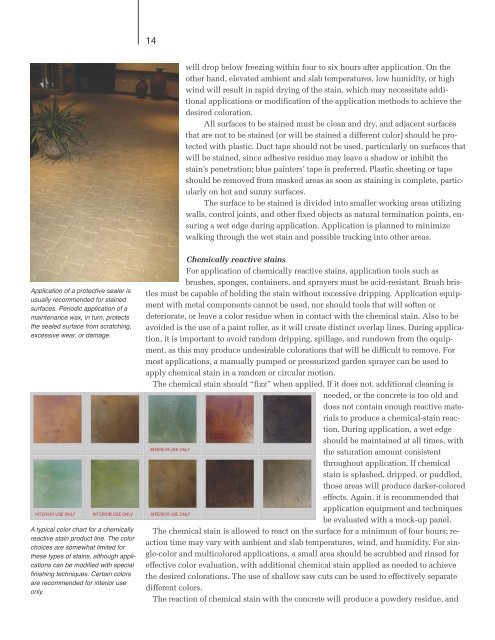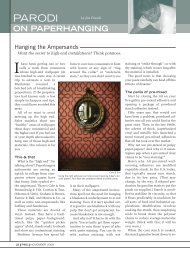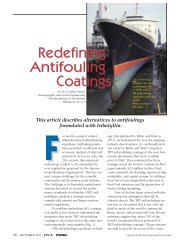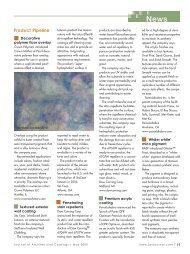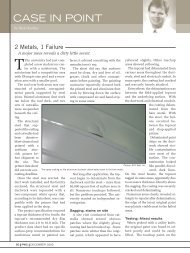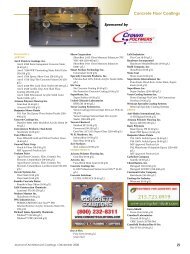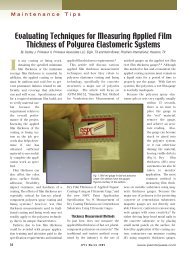Decorative Treatments for Concrete Floors: A ... - PaintSquare
Decorative Treatments for Concrete Floors: A ... - PaintSquare
Decorative Treatments for Concrete Floors: A ... - PaintSquare
Create successful ePaper yourself
Turn your PDF publications into a flip-book with our unique Google optimized e-Paper software.
14will drop below freezing within four to six hours after application. On theother hand, elevated ambient and slab temperatures, low humidity, or highwind will result in rapid drying of the stain, which may necessitate additionalapplications or modification of the application methods to achieve thedesired coloration.All surfaces to be stained must be clean and dry, and adjacent surfacesthat are not to be stained (or will be stained a different color) should be protectedwith plastic. Duct tape should not be used, particularly on surfaces thatwill be stained, since adhesive residue may leave a shadow or inhibit thestain’s penetration; blue painters’ tape is preferred. Plastic sheeting or tapeshould be removed from masked areas as soon as staining is complete, particularlyon hot and sunny surfaces.The surface to be stained is divided into smaller working areas utilizingwalls, control joints, and other fixed objects as natural termination points, ensuringa wet edge during application. Application is planned to minimizewalking through the wet stain and possible tracking into other areas.Application of a protective sealer isusually recommended <strong>for</strong> stainedsurfaces. Periodic application of amaintenance wax, in turn, protectsthe sealed surface from scratching,excessive wear, or damage.A typical color chart <strong>for</strong> a chemicallyreactive stain product line. The colorchoices are somewhat limited <strong>for</strong>these types of stains, although applicationscan be modified with specialfinishing techniques. Certain colorsare recommended <strong>for</strong> interior useonly.Chemically reactive stainsFor application of chemically reactive stains, application tools such asbrushes, sponges, containers, and sprayers must be acid-resistant. Brush bristlesmust be capable of holding the stain without excessive dripping. Application equipmentwith metal components cannot be used, nor should tools that will soften ordeteriorate, or leave a color residue when in contact with the chemical stain. Also to beavoided is the use of a paint roller, as it will create distinct overlap lines. During application,it is important to avoid random dripping, spillage, and rundown from the equipment,as this may produce undesirable colorations that will be difficult to remove. Formost applications, a manually pumped or pressurized garden sprayer can be used toapply chemical stain in a random or circular motion.The chemical stain should “fizz” when applied. If it does not, additional cleaning isneeded, or the concrete is too old anddoes not contain enough reactive materialsto produce a chemical-stain reaction.During application, a wet edgeshould be maintained at all times, withthe saturation amount consistentthroughout application. If chemicalstain is splashed, dripped, or puddled,those areas will produce darker-coloredeffects. Again, it is recommended thatapplication equipment and techniquesbe evaluated with a mock-up panel.The chemical stain is allowed to react on the surface <strong>for</strong> a minimum of four hours; reactiontime may vary with ambient and slab temperatures, wind, and humidity. For single-colorand multicolored applications, a small area should be scrubbed and rinsed <strong>for</strong>effective color evaluation, with additional chemical stain applied as needed to achievethe desired colorations. The use of shallow saw cuts can be used to effectively separatedifferent colors.The reaction of chemical stain with the concrete will produce a powdery residue, and


